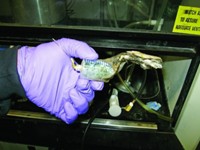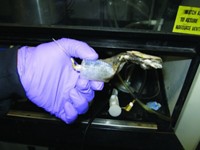Advertisement
Grab your lab coat. Let's get started
Welcome!
Welcome!
Create an account below to get 6 C&EN articles per month, receive newsletters and more - all free.
It seems this is your first time logging in online. Please enter the following information to continue.
As an ACS member you automatically get access to this site. All we need is few more details to create your reading experience.
Not you? Sign in with a different account.
Not you? Sign in with a different account.
ERROR 1
ERROR 1
ERROR 2
ERROR 2
ERROR 2
ERROR 2
ERROR 2
Password and Confirm password must match.
If you have an ACS member number, please enter it here so we can link this account to your membership. (optional)
ERROR 2
ACS values your privacy. By submitting your information, you are gaining access to C&EN and subscribing to our weekly newsletter. We use the information you provide to make your reading experience better, and we will never sell your data to third party members.
Safety
Safety In Academic Labs
by Rudy M. Baum
August 3, 2009
| A version of this story appeared in
Volume 87, Issue 31
Every issue of C&EN carries a variety of stories covering news and issues of significance to the chemistry enterprise. This week's cover story, for example, is our annual "Global Top 50 Chemical Producers" by Senior Editor Alex Tullo. The story presents a ranking, as it does every year, but it also looks at how the global economic recession has affected the world's leading chemical companies.
In the Government & Policy Department, Associate Editor Britt Erickson examines the emerging field of synthetic biology and whether and how it should be regulated. The ACS News Department contains information on two petitions that will be considered by the ACS Council at the upcoming national meeting in Washington, D.C., that could have a major impact on how candidates are selected for the society's national offices.
Sometimes, however, one story in an issue stands out as particularly consequential. In this week's issue, Associate Editor Jyllian Kemsley's in-depth examination of the details of an experiment in a laboratory at the University of California, Los Angeles, that led to a young researcher's death is such a story.
Kemsley has been covering this story since Sheharbano (Sheri) Sangji, a 23-year-old chemistry research assistant, died on Jan. 16 from injuries sustained in a chemical fire on Dec. 29, 2008 (C&EN Online Latest News, Jan. 22). Kemsley has written several stories on the investigation into Sangji's death and UCLA's response to the investigation and the fines that resulted from it.
The story in this week's issue is the most comprehensive and detailed examination of what happened to Sheri Sangji on that day in December that has been published. Kemsley used information from Sangji's lab notebook and from the notes and reports of the Office of the UCLA Fire Marshal, UCLA Fire Department, UCLA Police Department, UCLA Environmental Health & Safety, Los Angeles City Fire Department, and California Division of Occupational Safety & Health (Cal/OSHA) obtained through requests for public records.
The story Kemsley relates is both gripping and chilling. In December, Sangji was scaling up a reaction she had carried out at least once before, producing 4-hydroxy-4-vinyldecane from either 4-undecanone or 4-decanone. As Kemsley writes, the first step of the reaction was to generate vinyllithium by reacting vinylbromide with two equivalents of tert-butyllithium (tBuLi), a pyrophoric chemical that ignites spontaneously in air. The experiment went terribly wrong when, while drawing up tBuLi in roughly 50-mL aliquots, the air-reactive reagent was exposed to air.
The tBuLi and hexane from an overturned flask in the hood caught fire and ignited Sangji's clothes. She suffered second- and third-degree burns to 43% of her body.
In the aftermath of the accident, Cal/OSHA cited UCLA for numerous safety violations and fined the university $31,875 for lack of training, failing to correct unsafe laboratory conditions identified in an earlier inspection, and failing to ensure that employees wear appropriate protective equipment such as lab coats. UCLA has since taken numerous steps detailed by Kemsley to improve the safety practices in its labs.
The larger problem, however, as Kemsley points out in her article, is that the attitude toward safety practices in too many academic labs is lax. Anyone who has trained as a chemist and has experienced both academic and industrial labs knows that industry treats safety considerations more seriously and consistently than academia.
Many chemistry professors take safety seriously, but as one researcher Kemsley interviewed pointed out, "The culture varies too much from one research group to another" in academia. By contrast, the culture in industry more often is that safety is a job expectation and part of one's job performance.
Kemsley writes that "Sangji's death has inspired at least some members of the academic chemistry community to take stock of the safety practices in their labs." UCLA, not surprisingly, has made significant changes in the aftermath of Sangji's death beyond fixing the specific issues identified by Cal/OSHA. Let's work toward making sure that such changes extend throughout academe.
Thanks for reading.
Rudy Baum
Editor-in-chief
Views expressed on this page are those of the author and not necessarily those of ACS.




Join the conversation
Contact the reporter
Submit a Letter to the Editor for publication
Engage with us on Twitter